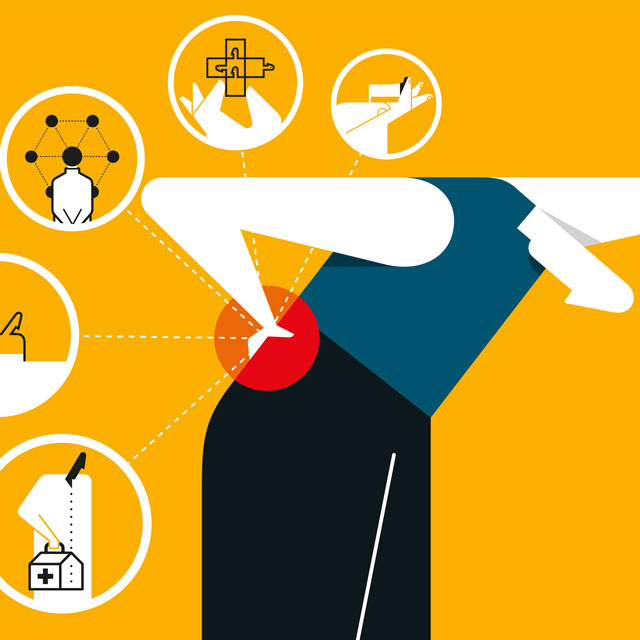Eric Strain is the director of the Johns Hopkins Center for Substance Abuse Treatment and Research and professor of psychiatry and behavioral sciences. In the following conversation, he discusses how to determine when someone is addicted to opioids and what factors may put people at greater risk for drug dependency.
Q: Are certain people more likely to become addicted than others?
Nobody is quite sure why one person becomes addicted to opioids and not another. Typically, opioids produce pain relief, which is good after surgery. However, for some people opioids create a pleasurable effect. For example, caffeine is a reinforcing drug — people like the effects. That is true for about 80 percent of the adult population in the U.S. But some people avoid caffeine because it makes them jittery or anxious. Early in the process of opioid use, some people may take it because of the pleasurable effect, and some don’t like the effect. If you take an opioid and your pain is gone, and you find yourself saying, “I feel really good,” it may be a warning sign. Over time that good effect diminishes for people who like how an opioid makes them feel. Many people take more opioids because they hope to get that good feeling, and they also don’t want to go through withdrawal.
Q: How addictive are opioids?
It generally takes one to two weeks to become physically dependent on an opioid but that varies by individual. If you take an opioid for a day or two it should not be a problem and, usually, you will not become addicted. However, some studies show even the first dose of an opioid can produce adaptation in the physiological effects.
For some time in this country, we believed patients who took opioids had a very low risk of addiction. No one knows for sure the percentage of those who are at risk. What we do know now through an annual survey of drug use in the U.S. is when people were asked if they had tried heroin, researchers found that 50 percent of those who had went on to have problematic heroin use. That shows how addictive these drugs can be.
We also know that the duration of opioid use can lead to physical dependence. If you’re taking an opioid regularly for a period of time, there’s a chance that you’ll become physically dependent, and that’s a risk factor for continued opioid use.
Q: Should I never take an opioid?
Opioids are effective painkillers and should be used appropriately. I think part of what the patient needs to do is to be responsible for their medical care. If you are going to have an elective or even an emergency procedure, it is incumbent on you to have a conversation with your physician about pain control. Ask questions such as, “You are prescribing me this many tablets, do I really need these?” “What is your strategy for pain control?” and, “What options do I have other than an opioid to help control my pain?”
Q: Is depression a risk factor for opioid addiction?
We know that there is a higher rate of addiction in populations with certain other diagnoses and especially those who have other substance use disorders such as alcoholism. We know that some studies show there are higher rates of depression in persons with opioid abuse, and it could be that being depressed was a risk factor for developing opioid abuse in certain people.
Q: How do you stop opioid addiction?
It isn’t difficult to get people off opioids — to withdraw them off — but the problem is that they have the urge to keep using the drugs. If someone is abusing opioids — a friend, colleague or loved one — the person needs to be motivated to end their addiction. You can’t do it for them. They must have some willingness to engage in treatment. The real challenge is staying off the drugs. Many people relapse. Good treatment, including medications such as buprenorphine, methadone and naltrexone, combined with therapy, can be very helpful and effective.
Q: How do you know if you are addicted?
I think of the defining feature of addiction as a dysregulation of choices. The person feels like they can no longer control their choice to use or not to use the drug, and they are driven to use. This dysregulation of choice can be seen as being governed by things inside of us such as physiologic drives and genetic vulnerabilities, and things outside of us including external cues in our environment and the availability of the drug. It helps me to sometimes think about eating to understand this — there can be a physical craving to eat if I haven’t eaten for hours, but environmental cues can also influence my choice to eat, even when I’m not hungry.
Opioid addiction is not simply like diseases such as pneumonia — there’s not a magic bullet that “cures” the person like an antibiotic can cure pneumonia. That doesn’t mean it is not a medical problem; it certainly is. But, we can think of opioid abuse as a medical illness that is governed by things inside the person as well as outside them. Treatments that consider the whole person can be particularly helpful because just addressing what’s outside or what’s inside the person may not really help the person in their recovery.
This story originally appeared in Wellness Matters, a publication of Howard County General Hospital.

